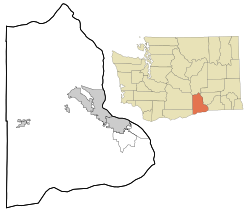History
The settlement of Valley Heights originated in 1907 when Seattle developer Charles Jorgen Smith, purchased property in present-day Whitstran, which became known as Valley Heights Orchard Tracts. [2] It was also called Swede Settlement for a time because of a number of Scandinavians who purchased property in the area. A rail line was built in 1911 and a town site was platted by Mary Biggam. By 1919 the community began to be known as Whitstran and the name Valley Heights eventually faded from use. [3]
The community's name was changed to Whitstran by the Northern Pacific Railway in honor of two retired railroad nurses, Laura Whitaker and May A. Strangeways, who were cousins who developed a small acreage nearby. [4]
Another source indicates that the town was named by the North Yakima and Valley Railway Company in honor of a landowner from whom a right-of-way had been acquired. The railway station was previously known as Whitstran Spur. [5]
E.W. Fry built the first store in Whitstran in 1916. Jim McCorkle has owned the store, now known as McCorkle's, since 1993. Previously it was known as Blake's Corner Market and Whitstran Trading Company. [6]
In the 1950s, a new school replaced the previous one room school. [6] The school is now Whitstran Elementary School.
This page is based on this
Wikipedia article Text is available under the
CC BY-SA 4.0 license; additional terms may apply.
Images, videos and audio are available under their respective licenses.






